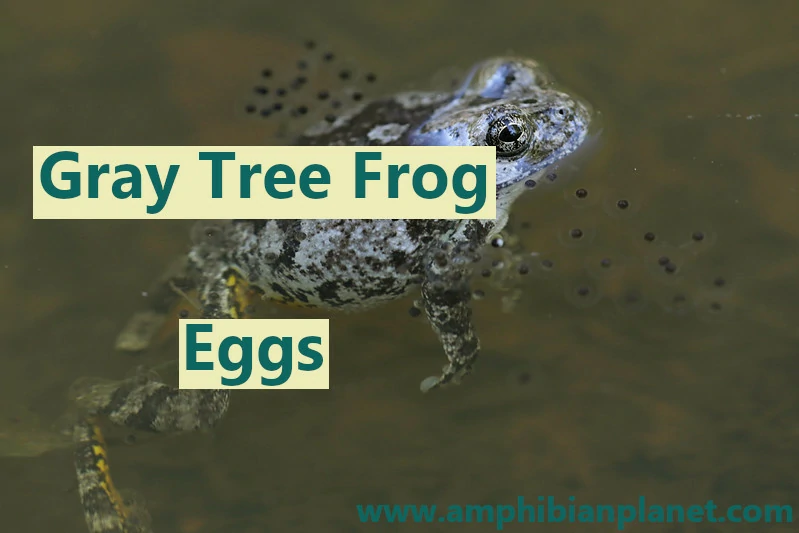Like most frogs, Gray tree frogs (Dryophytes versicolor), reproduce by laying eggs. These eggs are laid in shallow, fish-free freshwater bodies and attached to submerged vegetation near the water’s surface.
Like other frog eggs, Gray tree frog eggs do not have a hard outer shell to protect the developing embryos. Rather, each egg has a jelly coat.
This jelly coat absorbs UV-B some radiation, and also indirectly protects the eggs by virtue of its sticky texture and its tendency to accumulate a covering of pond debris.
Learning about Gray tree frog eggs is great to add to your knowledge and feed your curiosity. Read on to find out everything you need to know about Gray tree frog eggs including some really interesting facts, as well as how to easily identify them.
When Do Gray Tree Frogs Lay Their Eggs?
Gray tree frogs begin their breeding season in late April to early May, depending on latitude throughout their range, and will keep breeding through August.
These frogs emerge from their hibernation in the early months of spring. However, they do not begin their breeding season until the evening air temperature rises above 59°F (15°C).
Where Do Gray Tree Frog Lay Their Eggs?
Gray tree frogs generally lay their eggs in shallow, standing, or slow-moving, temporary freshwater bodies that are free of predatory fish.
Breeding sites include woodland ponds, flooded fields, seasonal pools, temporary rain puddles, flooded ditches, open marshes, swamps, and other wetlands.
They have also been known to lay eggs in backyard swimming pools, and even deep tire ruts filled with rainwater.

Gray tree frogs show a strong preference for temporary water bodies in which to lay their eggs – due to the absence of fish.
How Do Gray Tree Frogs Lay Their Eggs?
Male Gray tree frogs arrive first at breeding sites and will gather in trees and bushes next to breeding ponds and begin calling for mates.
Breeding males are very territorial, and will aggressively defend their territory from intruders.
Female Gray tree frogs arrive at the breeding sites a few days after the males.
Once at the breeding sites, the females will choose their mates depending on individual characteristics of the males’ calls – and head towards the calls of particular males.
The male then grasps her behind her forelimbs in a tight mating embrace called ‘amplexus’.
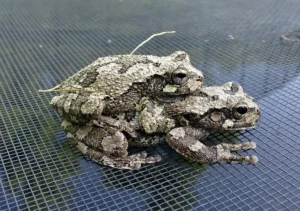
Once in the amplexus embrace, the pair will swim around as the female chooses a site to lay her eggs. The female then lays her eggs, and the male releases sperm into the water, to fertilize the eggs as the female lays them.
Eggs are laid on the surface of the water and are usually attached to vegetation to keep them from floating away.
How Many Eggs Do Gray Tree Frogs Lay?
A single female Gray tree frog can lay 1,000 – 2,000 eggs at a time. The eggs are laid in packets of 10 to 40 eggs.
The energetic cost of producing multiple clutches appears to be high for Gray tree frogs.
For this reason, the majority of females will only lay one clutch of eggs each breeding season.
Females that lay multiple clutches or a late initial clutch may not be able to lay early the following year.
Why Do Gray Tree Frogs Lay So Many Eggs?
Gray tree frogs, like other frogs, lay large numbers of eggs as a natural way to counter the extremely high mortality rates they experience in their early life stages.
Gray tree frogs leave their eggs shortly after laying them. This means the eggs (and tadpoles) are vulnerable to predators, and environmental conditions – leading to very low survival rates.
Of the tadpoles that hatch, there will be intense competition for food and limited resources, meaning again the number of tadpoles will naturally thin out.
When the froglets leave the water, only a few will live to adulthood and reproduce – which can be as low as 1%. The rest will get eaten by predators such as birds, snakes, larger frogs, and small mammals such as foxes.
The large number of eggs laid by each frog is crucial to the survival of its species. If just 5 out of 1000 eggs laid becomes an adult frog and lives long enough to breed, the population of that species should increase.
What Do Gray Tree Frog Eggs Look Like?
Gray tree frog eggs are small and soft-shelled eggs, arranged in packets on the surface of the water.
Oftentimes, they are generally really close to, or loosely attached to debris, branches, or emergent vegetation


Each egg is dark brown on the top and a yellowish cream color on the bottom, and is surrounded by a protective gelatinous mass.
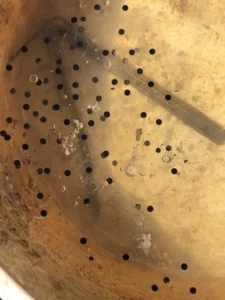

This jelly enables the eggs to float near the surface of the water, where it is warmer and there is more oxygen.
The jelly also holds the eggs together and protects the developing embryos from the elements by virtue of its sticky texture and its tendency to accumulate a covering of pond debris.
In addition, it acts as a “shock absorber” to prevent injury to the egg from the water movement.
As the embryos develop, Gray tree egg masses will deteriorate and flatten to the point where individual eggs are no longer identifiable from the rest of the floating raft.
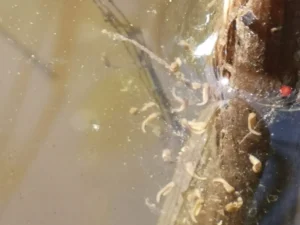
How Long Do Gray Tree Frog Eggs Take To Hatch?
Gray tree frog eggs take about 3 to 7 days to hatch, depending on the environmental conditions.
The eggs will typically develop and hatch faster in warmer temperatures and slower in colder temperatures.
What Do Gray Tree Frog Tadpoles Look Like?
Gray tree frog tadpoles have rounded bodies with high, wide tail fins.

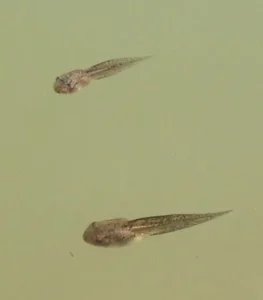
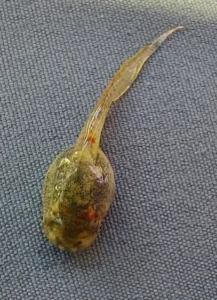
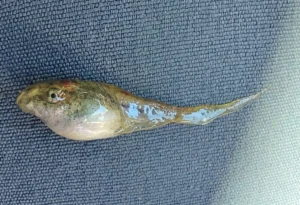
They have inconsistent coloring, which may include different shades of brown or olive green.
The body and tail are patterned with many specks of black and gold – and black blotches may be present around the edge of the tail.
Interestingly, gray tree frog tadpoles can develop a bright red coloration on their tail when they are exposed to predators such as dragonfly larvae.
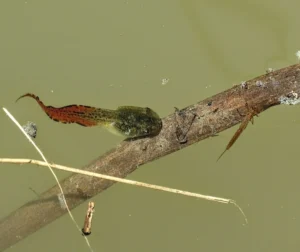
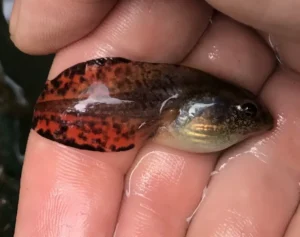
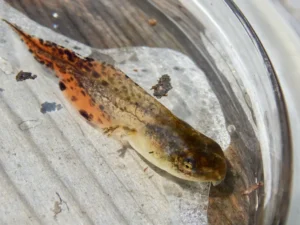
The ability of a single genotype to develop alternative traits in different environments is known as “phenotypic plasticity.
Studies suggest the red pigments in the tail may help to misdirect predator attacks.
Gray tree frog tadpoles will complete their development into frogs about 45 to 65 days after they hatch.
Do Gray Tree Frogs Care For Their Tadpoles?
Gray tree frogs do not attend to their tadpoles or care for them in any way.
Once mating and egg-laying are complete, both the males and females will leave the pond, only returning the next breeding season.
What Animals Prey on Gray Tree Frog Eggs and Tadpoles?
Gray tree frog eggs are preyed on by many animals including newts, turtles, leeches, dragonfly larvae, diving beetles, and other large water bugs.
Once the tadpoles hatch, they are preyed on by
- Fish (if present in the pond)
- Dragonfly naiads
- Giant water bugs
- Larger amphibian larvae, such as tiger salamander (Ambystomma tigrinum) larvae.
- Newts and salamanders
- Some adult frogs, such as American Bullfrogs (Lithobates catesbeiana)
- Turtles
- Water snakes
- Wading birds, such as herons (Ardeidae)
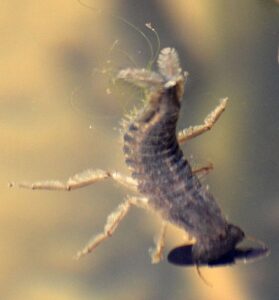
What to Do if You Find Gray Tree Frog Eggs
If you live near a wooded area, especially near a pond, or another freshwater body there’s a chance of encountering Gray tree frog eggs in the spring. If this happens, be sure to avoid disturbing the eggs.
Disturbing or removing the eggs from the water could damage them, or even kill the tiny embryos developing inside the eggs.
If you find Gray tree frog eggs out of the water, it is best to leave them alone, especially if they are very near the water.
However, if you find frog eggs that were disturbed (by a human or animal) and taken out of the water, you could try to put them back in the water.
If the egg mass is still attached to a stick, very gently put the stick back in the water (just a few inches below the surface).
Still, the eggs are not guaranteed to hatch because the disturbance may have damaged them or killed the embryos developing inside.
Of course, there’s no harm in observing frog eggs from a distance.
Featured image credit: cotinis (CC BY-NC 2.0 DEED)
Sources:
Ritke, M. E., Babb, J. G., & Ritke, M. K. (1990). Life History of the Gray Treefrog (Hyla chrysoscelis) in Western Tennessee. Journal of Herpetology, 24(2), 135–141. https://doi.org/10.2307/1564220
Harding, 1997. Amphibians and Reptiles of the Great Lakes Region. Ann Arbor, Michigan: University of Michigan Press.
McCollum, S. A., & Van Buskirk, J. (1996). Costs and Benefits of a Predator-Induced Polyphenism in the Gray Treefrog Hyla Chrysoscelis. Evolution, 50(2), 583–593. https://doi.org/10.2307/2410833
AmphibiaWeb. Hyla versicolor Eastern Gray Treefrog. University of California, Berkeley, CA, USA.
Virginia Herpetological Society. Gray Treefrog Hyla versicolor.

